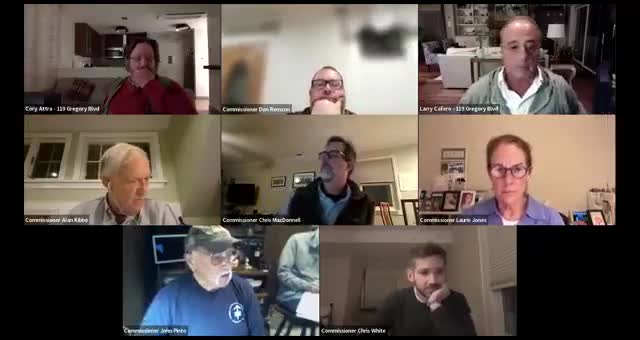Commission approves Charles Cove bulkhead repair plan, with conditions for erosion controls
October 23, 2025 | Norwalk City, Fairfield, Connecticut
This article was created by AI summarizing key points discussed. AI makes mistakes, so for full details and context, please refer to the video of the full meeting. Please report any errors so we can fix them. Report an error »

The Norwalk Harbor Management Commission voted Oct. 22 to recommend that a proposed bulkhead repair at Charles Cove — a condominium community on Gregory Boulevard — is consistent with the Harbor Management Plan, with conditions requiring best‑management practices to prevent sedimentation into Norwalk Harbor and Long Island Sound.
Larry Cafaro, a Charles Cove resident, told commissioners the bulkhead on the east side "has been failing somewhat, slightly. We want to repair it before it gets worse." The project would avoid in‑water work by installing about 540 feet of cast‑in‑place concrete slurry walls behind the existing timber bulkhead and using existing tiebacks and piles for reinforcement.
Corey Atra, a professional engineer, described a plan to excavate behind the existing timber face, install filtered fabric, repair sinkholes, weld tension plates to existing tiebacks and pour a reinforced concrete wall. "This is a tidal zone," Atra said. "Everything's tidal dependent. We've given consideration to what's called tremipore, which is a process by which you can pour concrete when you're underwater. But ideally, they're able to time this...at low tide." He also said the tiebacks inspected were "in pretty good condition."
Permitting and jurisdiction: the applicants said they contacted the Connecticut Department of Energy and Environmental Protection (DEEP) and were told the work does not fall within the state's coastal jurisdiction because it takes place landward of the coastal jurisdiction line. The applicants then submitted the drawings to Norwalk Harbor staff and sought the Harbor Management Commission's review for a municipal permit.
The commission's Application Review Committee recommended that the project be considered consistent with the harbor management plan provided the permit includes clear erosion‑and‑sediment controls and monitoring requirements. That recommendation was moved, seconded and approved by the commission. Commissioners specifically asked that construction require the applicant's submitted sediment‑and‑erosion control plan and restoration measures and that the permit include conditions ensuring protection of wetland areas and avoidance of in‑water disturbance.
Outcome: the commission voted to recommend approval with the conditions noted; the applicant will proceed through Norwalk’s permitting process and coordinate with staff on final permit conditions. No roll‑call vote names were recorded in the meeting transcript.
Ending: Applicants said they will provide final drawings and sedimentation control details to the city and Harbor Commission as part of the municipal permitting process.
Larry Cafaro, a Charles Cove resident, told commissioners the bulkhead on the east side "has been failing somewhat, slightly. We want to repair it before it gets worse." The project would avoid in‑water work by installing about 540 feet of cast‑in‑place concrete slurry walls behind the existing timber bulkhead and using existing tiebacks and piles for reinforcement.
Corey Atra, a professional engineer, described a plan to excavate behind the existing timber face, install filtered fabric, repair sinkholes, weld tension plates to existing tiebacks and pour a reinforced concrete wall. "This is a tidal zone," Atra said. "Everything's tidal dependent. We've given consideration to what's called tremipore, which is a process by which you can pour concrete when you're underwater. But ideally, they're able to time this...at low tide." He also said the tiebacks inspected were "in pretty good condition."
Permitting and jurisdiction: the applicants said they contacted the Connecticut Department of Energy and Environmental Protection (DEEP) and were told the work does not fall within the state's coastal jurisdiction because it takes place landward of the coastal jurisdiction line. The applicants then submitted the drawings to Norwalk Harbor staff and sought the Harbor Management Commission's review for a municipal permit.
The commission's Application Review Committee recommended that the project be considered consistent with the harbor management plan provided the permit includes clear erosion‑and‑sediment controls and monitoring requirements. That recommendation was moved, seconded and approved by the commission. Commissioners specifically asked that construction require the applicant's submitted sediment‑and‑erosion control plan and restoration measures and that the permit include conditions ensuring protection of wetland areas and avoidance of in‑water disturbance.
Outcome: the commission voted to recommend approval with the conditions noted; the applicant will proceed through Norwalk’s permitting process and coordinate with staff on final permit conditions. No roll‑call vote names were recorded in the meeting transcript.
Ending: Applicants said they will provide final drawings and sedimentation control details to the city and Harbor Commission as part of the municipal permitting process.
View the Full Meeting & All Its Details
This article offers just a summary. Unlock complete video, transcripts, and insights as a Founder Member.
✓
Watch full, unedited meeting videos
✓
Search every word spoken in unlimited transcripts
✓
AI summaries & real-time alerts (all government levels)
✓
Permanent access to expanding government content
30-day money-back guarantee

